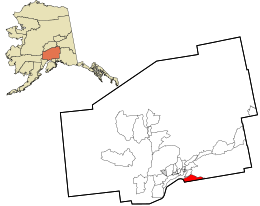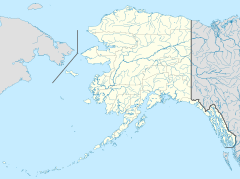Knik River, Alaska facts for kids
Quick facts for kids
Knik River, Alaska
|
|
|---|---|

Location in Matanuska-Susitna Borough and the state of Alaska.
|
|
| Country | United States |
| State | Alaska |
| Borough | Matanuska-Susitna |
| Area | |
| • Total | 91.68 sq mi (237.44 km2) |
| • Land | 81.72 sq mi (211.65 km2) |
| • Water | 9.96 sq mi (25.79 km2) |
| Population
(2020)
|
|
| • Total | 792 |
| • Density | 9.69/sq mi (3.74/km2) |
| Time zone | UTC-9 (Alaska (AKST)) |
| • Summer (DST) | UTC-8 (AKDT) |
| Area code(s) | 907 |
| FIPS code | 02-40670 |
Knik River is a small community in Matanuska-Susitna Borough, Alaska, in the United States. It's about 15 miles southeast of Palmer, right next to the Knik River. It's also considered part of the larger Anchorage area. In 2020, about 792 people lived there, which was a bit more than in 2010.
Contents
Geography and Climate in Knik River
Knik River is located in Southcentral Alaska, about 27 kilometers (17 miles) northeast of Anchorage. It sits at the very end of the Knik Arm, which is a part of Cook Inlet. The community has grown along the south side of the Knik River, which flows into the Knik Arm.
The area covers about 93.2 square miles (241.4 square kilometers). Most of this area is land, with a smaller part being water.
Weather in Knik River
The weather in Knik River can be quite cold in winter and warm in summer.
- In January, temperatures can range from -35°F (-37°C) to 33°F (1°C).
- In July, temperatures are usually between 72°F (6°C) and 85°F (29°C).
The area gets about 16.5 inches (42 cm) of rain each year, and about 43 inches (109 cm) of snow.
History of Knik River
The first people to live in this area were the Knik (Arm area) or K′enah Ht’ana band of Dena'ina Athabascans. They used to travel through the region on a winter trail. This trail went from Eklutna up the Knik River to the Copper River.
In 1942, the Palmer Road, now known as the Old Glenn Highway, was built through the area. A popular lodge on Goat Creek was a favorite stop for travelers. The Eklutna Power Project was also built in the 1940s, which included homes for its workers. The Knik River Road started as a logging road in the early 1950s and was later improved. Today, part of the road is paved.
Population of Knik River
Knik River was first counted as a census-designated place (CDP) in the U.S. Census in 2000.
| Historical population | |||
|---|---|---|---|
| Census | Pop. | %± | |
| 2000 | 582 | — | |
| 2010 | 744 | 27.8% | |
| 2020 | 792 | 6.5% | |
| U.S. Decennial Census | |||
In 2000, there were 582 people living in Knik River. About 38.9% of the homes had children under 18. The average age of people living there was 36 years old. Most people were White, but there were also Native American, Pacific Islander, and other racial groups. Some residents were of Hispanic or Latino background.
Public Services in Knik River
Most homes in Knik River use their own wells for water and septic systems for waste. Some residents have private water systems, while others bring in water and use outhouses. The Eklutna Power Project, which helps provide electricity, is located in the community.
The local Borough offers a place to drop off trash. Electricity is supplied by the Matanuska Electric Association. There are no state-run schools directly in Knik River. For medical care, residents can go to Valley Hospital in Palmer or hospitals in Anchorage. There is also an ambulance service available.
Economy and Transportation
Many people who live in Knik River work in nearby Anchorage or the Palmer/Wasilla area. They work in various jobs, including retail (stores), transportation, and education.
Knik River is located off the Glenn Highway, which is a main road. Other ways to get around, like public transportation, are available in Palmer and Anchorage.
Taxes in Knik River
There is no sales tax in Knik River. There is a property tax set by the Borough, and a special 5% tax on accommodations (like hotels or rentals).
Knik River in Popular Culture
- Jessie Arnold, a made-up character in a series of mystery books by author Sue Henry, lives near Palmer in the Knik River valley. She is a musher in the Iditarod.
- The Knik River was shown in an episode of the TV show I Shouldn't Be Alive, called Escape From Bear Mountain.
See also
 In Spanish: Knik River (Alaska) para niños
In Spanish: Knik River (Alaska) para niños


